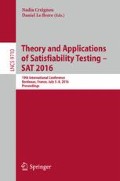Abstract
A picture over a finite alphabet \(\varGamma \) is a matrix whose entries are drawn from \(\varGamma \). Let \(\pi :\varSigma \rightarrow \varGamma \) be a function between finite alphabets \(\varSigma \) and \(\varGamma \), and let \(V,H\subseteq \varSigma \times \varSigma \) be binary relations over \(\varSigma \). Given a picture \(N\) over \(\varGamma \), the picture satisfiability problem consists in determining whether there exists a picture M over \(\varSigma \) such that \(\pi (M_{ij})=N_{ij}\), and such that the constraints imposed by V and H on adjacent vertical and horizontal positions of M are respectively satisfied. This problem can be easily shown to be NP-complete. In this work we introduce the notion of s-smooth picture. Our main result states the satisfiability problem for s-smooth pictures can be solved in time polynomial on s and on the size of the input picture. With each picture \(N\), one can naturally associate a CNF formula \(F(N)\) which is satisfiable if and only if \(N\) is satisfiable. In our second result, we define an infinite family of unsatisfiable pictures which intuitively encodes the pigeonhole principle. We show that this family of pictures is polynomially smooth. In contrast we show that the formulas which naturally arise from these pictures are hard for bounded-depth Frege proof systems. This shows that there are families of pictures for which our algorithm for the satisfiability for smooth pictures performs exponentially better than certain classical variants of SAT solvers based on the technique of conflict-driven clause-learning (CDCL).
Access this chapter
Tax calculation will be finalised at checkout
Purchases are for personal use only
Notes
- 1.
Recall that the first and last columns of the pigeonhole picture do not correspond to holes.
References
Beame, P., Kautz, H., Sabharwal, A.: Towards understanding and harnessing the potential of clause learning. J. Artif. Intell. Res. 22, 319–351 (2004)
Beame, P., Pitassi, T.: Simplified and improved resolution lower bounds. In: Proceedings of the 37th Annual Symposium on Foundations of Computer Science, pp. 274–282. IEEE (1996)
Buss, S.R., et al.: Resolution proofs of generalized pigeonhole principles. Theoret. Comput. Sci. 62(3), 311–317 (1988)
Buss, S.R., Hoffmann, J., Johannsen, J.: Resolution trees with lemmas: resolution refinements that characterize DLL algorithms with clause learning. Logical Meth. Comput. Sci. 4, 1–18 (2008)
Cherubini, A., Reghizzi, S.C., Pradella, M., San, P.: Picture languages: Tiling systems versus tile rewriting grammars. Theoret. Comput. Sci. 356(1), 90–103 (2006)
Cook, S.A., Reckhow, R.A.: The relative efficiency of propositional proof systems. J. Symbol. Logic 44(01), 36–50 (1979)
Eén, N., Sörensson, N.: An extensible SAT-solver. In: Giunchiglia, E., Tacchella, A. (eds.) SAT 2003. LNCS, vol. 2919, pp. 502–518. Springer, Heidelberg (2004)
Giammarresi, D., Restivo, A.: Recognizable picture languages. Int. J. Pattern Recogn. Artif. Intell. 6(2&3), 241–256 (1992)
Haken, A.: The intractability of resolution. Theoret. Comput. Sci. 39, 297–308 (1985)
Hertel, P., Bacchus, F., Pitassi, T., Van Gelder, A.: Clause learning can effectively P-simulate general propositional resolution. In: Proceedings of the 23rd National Conference on Artificial Intelligence (AAAI 2008), pp. 283–290 (2008)
Kim, C., Sudborough, I.H.: The membership and equivalence problems for picture languages. Theoret. Comput. Sci. 52(3), 177–191 (1987)
Krajíček, J.: Lower bounds to the size of constant-depth propositional proofs. J. Symbol. Logic 59(01), 73–86 (1994)
Krajíček, J., Pudlák, P., Woods, A.: An exponential lower bound to the size of bounded depth frege proofs of the pigeonhole principle. Random Struct. Algorithms 7(1), 15–39 (1995)
Latteux, M., Simplot, D.: Recognizable picture languages and domino tiling. Theoret. Comput. Sci. 178(1), 275–283 (1997)
Maurer, H.A., Rozenberg, G., Welzl, E.: Using string languages to describe picture languages. Inf. Control 54(3), 155–185 (1982)
Moskewicz, M.W., Madigan, C.F., Zhao, Y., Zhang, L., Malik, S.: Chaff: engineering an efficient SAT solver. In: Proceedings of the 38th Annual Design Automation Conference, pp. 530–535. ACM (2001)
Pipatsrisawat, K., Darwiche, A.: On the power of clause-learning SAT solvers as resolution engines. Artif. Intell. 175(2), 512–525 (2011)
Pitassi, T., Beame, P., Impagliazzo, R.: Exponential lower bounds for the pigeonhole principle. Comput. Complex. 3(2), 97–140 (1993)
Raz, R.: Resolution lower bounds for the weak pigeonhole principle. J. ACM (JACM) 51(2), 115–138 (2004)
Revuz, D.: Minimisation of acyclic deterministic automata in linear time. Theoret. Comput. Sci. 92(1), 181–189 (1992)
Rosenfeld, A.: Picture Languages: Formal Models for Picture Recognition. Academic Press (2014)
Simplot, D.: A characterization of recognizable picture languages by tilings by finite sets. Theoret. Comput. Sci. 218(2), 297–323 (1999)
Stromoney, G., Siromoney, R., Krithivasan, K.: Abstract families of matrices and picture languages. Comput. Graph. Image Process. 1(3), 284–307 (1972)
Acknowledgments
This work was supported by the European Research Council, grant number 339691, in the context of the project Feasibility, Logic and Randomness (FEALORA). The author thanks Pavel Pudlák and Neil Thapen for enlightening discussions on Frege proof systems.
Author information
Authors and Affiliations
Corresponding author
Editor information
Editors and Affiliations
Rights and permissions
Copyright information
© 2016 Springer International Publishing Switzerland
About this paper
Cite this paper
de Oliveira Oliveira, M. (2016). Satisfiability via Smooth Pictures. In: Creignou, N., Le Berre, D. (eds) Theory and Applications of Satisfiability Testing – SAT 2016. SAT 2016. Lecture Notes in Computer Science(), vol 9710. Springer, Cham. https://doi.org/10.1007/978-3-319-40970-2_2
Download citation
DOI: https://doi.org/10.1007/978-3-319-40970-2_2
Published:
Publisher Name: Springer, Cham
Print ISBN: 978-3-319-40969-6
Online ISBN: 978-3-319-40970-2
eBook Packages: Computer ScienceComputer Science (R0)

